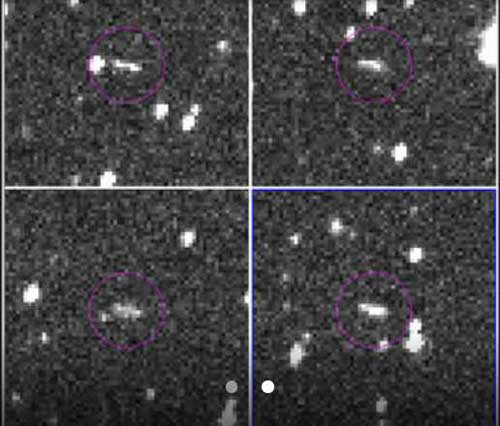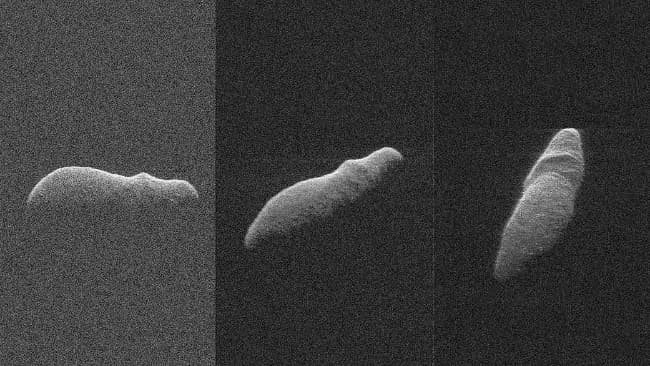 This GIF shows the flash of an asteroid impacting Earth’s atmosphere over the Caribbean Sea on June 22, 2019. It was captured by the Geostationary Lightning Mapper instrument aboard GOES-16, an Earth-monitoring satellite operated by NOAA and NASA. CIRA/CSU, RAMMB/NOAA/NASA
This GIF shows the flash of an asteroid impacting Earth’s atmosphere over the Caribbean Sea on June 22, 2019. It was captured by the Geostationary Lightning Mapper instrument aboard GOES-16, an Earth-monitoring satellite operated by NOAA and NASA. CIRA/CSU, RAMMB/NOAA/NASA
› Larger view
When a lightning detector on a NOAA weather satellite detected something that wasn’t lightning last Saturday, a scientist at the Center for Near Earth Object Studies at NASA’s Jet Propulsion Laboratory in Pasadena, California, did some detective work.
Could a tiny, harmless object that broke up in the atmosphere in a bright flash be connected to a just-received automated alert of a potential near-Earth asteroid discovery? Although far below the size that NASA is tasked to detect and track, the event presented an ideal opportunity for NASA planetary defense teams to test their parts of the alert system.
The outcome? The flow of alert data works, and the culprit was identified: It was an asteroid. Now designated 2019 MO, the asteroid was only about 16 feet (5 meters) in size and was detected at 9:45 UTC (2:45 a.m. PDT, 5:45 a.m. EDT) on Saturday, June 22, by the University of Hawaii’s ATLAS survey telescope on Maunaloa in Hawaii.
When first spotted, 2019 MO was about 310,000 miles (500,000 kilometers) from Earth – farther out than the orbit of our Moon. This was roughly the equivalent of spotting something the size of a gnat from a distance of 310 miles (500 kilometers).
The initial four observations by ATLAS were submitted to the NASA-funded Minor Planet Center (the worldwide data processing node for asteroid observations) and immediately assessed by automated impact-analysis software, called Scout, at JPL. Scout quickly identified a possible impact. The observations were too few to provide certainty but did show the size would be far too small to be of concern.
“Asteroids this size are far smaller than what we’re tasked to track,” said Davide Farnocchia, a scientist at the Center for Near Earth Object Studies, which operates Scout. “They’re so small, they would not survive passing through our atmosphere to cause damage to Earth’s surface. But this event shows how capable our search programs are, even for objects of such small sizes.”
Scout works by processing sky-position measurements of each potential new asteroid and rapidly computing the possible range of future motion even before these objects have been confirmed as discoveries.
The mystery was closer to being solved in the early evening of June 22, when a NOAA-NASA weather satellite called GOES-16 carrying a Geostationary Lightning Mapper reported a possible bolide – the bright flash of an asteroid impacting Earth’s atmosphere – over the Caribbean Sea. JPL’s Farnocchia recognized that the object Scout flagged earlier that day could have caused that bolide, and he dug into the data. He computed a viable trajectory that would fit the coordinates of both the flash captured by the lightning mapper and the ATLAS observations of about 12 hours earlier.
[content id=”79272″]
Farnocchia noted the data on the tiny, new asteroid were not yet conclusive: The body had been spotted only four times in just under half an hour, which was not enough information to determine where the object came from or exactly where it was headed.
Luckily, the NASA-funded Pan-STARRS 2 survey telescope on Maui had imaged the part of the sky where the small asteroid could have been visible a couple of hours before the ATLAS observations. Using the potential orbit Farnocchia had calculated, Pan-STARRS scientists Robert Weryk and Mark Huber, both at the University of Hawaii Institute for Astronomy, and Marco Micheli at the European Space Agency located the asteroid in images that had been taken just before the ATLAS observations.
With these additional observations, a more precise trajectory for the asteroid was calculated and the puzzle was solved: The object that impacted the atmosphere over the Caribbean was the asteroid detected by ATLAS just 12 hours earlier and flagged by Scout.
The impact of Asteroid 2019 MO has now been confirmed by international infrasound and other US Government sensors and added to the CNEOS Fireball Map.
JPL hosts the Center for Near-Earth Object Studies (CNEOS) for NASA’s Near-Earth Object Observations Program in NASA’s Planetary Defense Coordination Office.
More information about CNEOS, asteroids and near-Earth objects can be found at:
For more information about NASA’s Planetary Defense Coordination Office, visit:
https://www.nasa.gov/planetarydefense
Source: NASA






